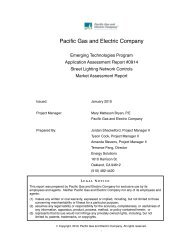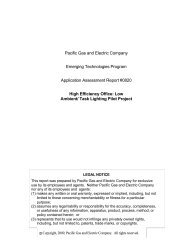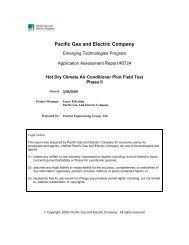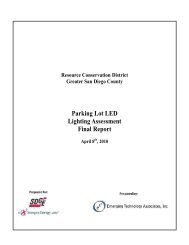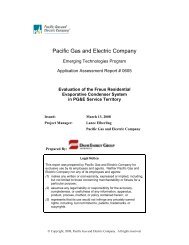Laboratory Evaluation of the OASys Indirect/Direct Evaporative
Laboratory Evaluation of the OASys Indirect/Direct Evaporative
Laboratory Evaluation of the OASys Indirect/Direct Evaporative
Create successful ePaper yourself
Turn your PDF publications into a flip-book with our unique Google optimized e-Paper software.
2<br />
Wet Bulb Outlet<br />
Dry Bulb<br />
Figure 3: Simplified <strong>Direct</strong> <strong>Evaporative</strong> Cooler Process<br />
Temperature<br />
40%<br />
Relative<br />
Humidity<br />
491-06.12.doc 4<br />
100%<br />
80%<br />
Constant Wet Bulb<br />
1<br />
Inlet<br />
Dry Bulb<br />
60%<br />
Ambient<br />
20%<br />
<strong>Indirect</strong> <strong>Evaporative</strong> Cooling Process<br />
<strong>Evaporative</strong>ly cooled air can be used with an air-to-air heat exchanger to cool sensibly a second stream <strong>of</strong><br />
air without changing its moisture content, thus creating an “indirect” evaporative cooler. Due to heat<br />
exchange inefficiencies, <strong>the</strong> temperature <strong>of</strong> <strong>the</strong> delivered air will be higher than that provided by <strong>the</strong><br />
direct evaporative cooler. A simplified version <strong>of</strong> this process is shown in Figure 4. The resulting supply<br />
and exhaust temperatures will depend on <strong>the</strong> effectiveness <strong>of</strong> <strong>the</strong> heat exchanger and <strong>the</strong> relative<br />
magnitude <strong>of</strong> <strong>the</strong> two airflows. Although this example shows <strong>the</strong> intakes to both air paths from <strong>the</strong> same<br />
source (ambient air at point 1), <strong>the</strong> intake to ei<strong>the</strong>r could be different. For example, indirectly cooling<br />
return air using outside air, or indirectly cooling outside air using exhaust air.<br />
Dew Point<br />
Wet Bulb<br />
2<br />
<strong>Direct</strong><br />
Outlet<br />
Figure 4: Simplified <strong>Indirect</strong> <strong>Evaporative</strong> Cooler Process<br />
4<br />
<strong>Indirect</strong><br />
Outlet<br />
100%<br />
80%<br />
3<br />
Exhaust<br />
1<br />
Inlet<br />
Dry Bulb<br />
60%<br />
Ambient<br />
40%<br />
Relative<br />
Humidity<br />
20%<br />
Humidity Ratio<br />
Humidity Ratio<br />
Temperature<br />
Ambient<br />
Inlet<br />
Exhaust<br />
<strong>Direct</strong><br />
Outlet<br />
<strong>Indirect</strong><br />
Outlet<br />
4<br />
Heat<br />
Exchanger<br />
One advantage <strong>of</strong> <strong>the</strong> sensible cooling done through <strong>the</strong> heat exchanger is that it not only reduces <strong>the</strong> drybulb<br />
temperature <strong>of</strong> <strong>the</strong> air, but also its wet-bulb temperature. This means that <strong>the</strong> indirectly cooled air<br />
can be cooled fur<strong>the</strong>r by using it as <strong>the</strong> inlet to ano<strong>the</strong>r stage <strong>of</strong> direct or indirect evaporative cooling<br />
(Point 4 becomes Point 1 for <strong>the</strong> second stage).<br />
The <strong>OASys</strong> system takes advantage <strong>of</strong> this by exhausting a portion <strong>of</strong> <strong>the</strong> sensibly cooled air to do <strong>the</strong><br />
evaporative cooling, thus utilizing this lowered wet-bulb temperature. Ra<strong>the</strong>r than separate stages as in<br />
Figure 4, <strong>the</strong> <strong>OASys</strong> indirect cooling module uses a wetted section for <strong>the</strong> exhaust stream combining <strong>the</strong><br />
1<br />
1<br />
1<br />
Pad<br />
Inlet Outlet<br />
Water Pan<br />
Pump<br />
3<br />
2<br />
2




